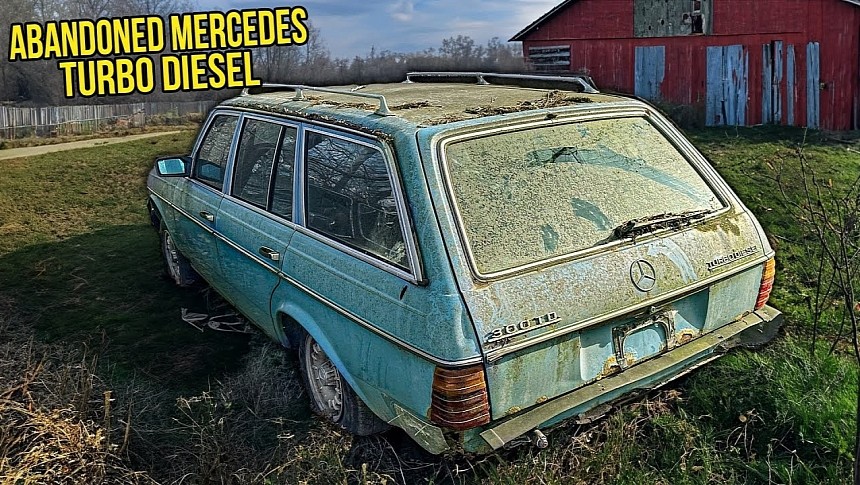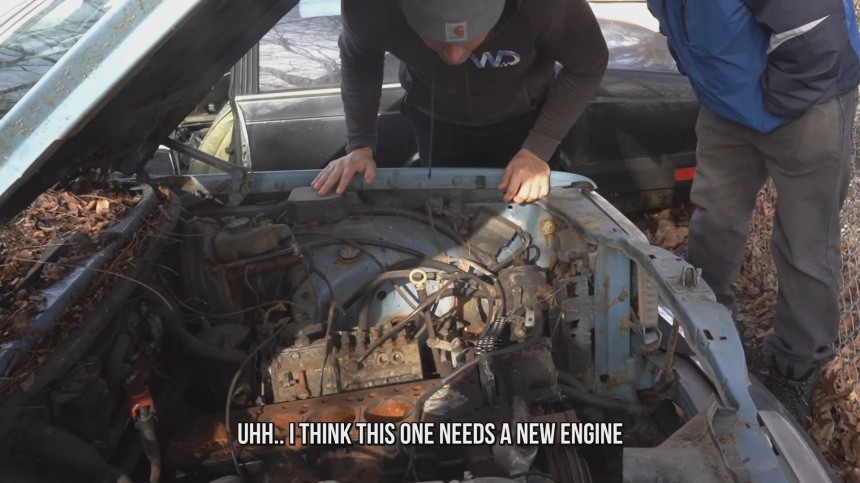Mercedes has a traditionally agreed reliable reputation and is probably one of the top five role-model situations when ‘German Engineering’ comes into a conversation as an undeniable proof of high-class craftsmanship. While this theorem might not hold water in this computer day and age of atrocious careless consumerism, there was a time not too long ago when the European brand built its cars by smelting Thor’s hammer and casting it in a five-cylinder diesel engine – the unbreakable 300 turbodiesel of the late seventies.
Multiple accounts of the legendary W123 Mercedes-Benz running smoothly for over one million kilometers (some 620,000 miles) with no significant mechanical issues are easy to find. There are reports of examples going well over one million miles (1.6 million kilometers) with nothing but fresh oil, regular maintenance, and smiles per gallon. In the late eighties, when the 300Ds would reach said milestones, the Mercedes-Benz cars found their way to Africa or Latin America, where they would endure for decades with impeccable resilience.
In popular culture, frequent jokes about the extremely high standards of said importing countries claimed that the third-world drivers were so severe in their requirements that a one-million-mile break-in was necessary to prove the Mercs were up to their needs. While it’s a folklore tale about a sturdy automobile, the truth is those cars and their engines were made to last for as long as the road lasted (asphalt or not).
The 300D inline-five debuted in 1979 as the world’s first turbodiesel passenger car in the W123 Mercedes-Benz and was dedicated to the European market. Two years later, the Americans understood what proper Diesel technology was about. The sales literature of the time touted, ‘Unlike many Diesels which are simply converted gasoline engines, Mercedes-Benz has designed this engine from the ground up to meet the rigorous compression requirements of the Diesel.’
Mercedes was pointing the finger (and it wasn’t the index) at Oldsmobile’s 350-cubic-inch V8 diesel motor, which was a catastrophically hasty attempt at fighting the energy crunch of the era. However, the American eight-cylinder Frankenstein was an adaptation of the 5.7-liter gasoline engine, and it showed its flaws in the long run. Today, that Olds foot-in-mouth powerplant is widely held responsible for being the main reason Americans still don’t appreciate self-igniting engines very much.
Furthermore, twisting the knife in the oil embargo wound, the Germans bragged about their straight-five fuel efficiency – ‘it can operate on the cheapest automotive fuel you can buy.’ As innovative drivers later proved, the rugged plant would run on cooking oils – either straight or used – without a hiccup.
But even those virtually indestructible W123s weren’t impervious to misdemeanors, and this desecrated 1981 300TD example found in a yard is proof. It's not living proof because its formidable straight-five is dead. Everything above the top dead center of the pistons is no more, and this sturdy Diesel will never run again unless someone decides to replace its broken heart. However, the rest of the Mercedes-Benz is in good shape despite being pulled out of a backyard where it sat under the open skies long enough to allow a solid layer of mold to grow.
Premiered in April 1978, the 300TD was the most expensive station wagon available, at roughly $15,000. In a way, it introduced America to the concept of luxurious practicality, combining the multi-tool versatility of a wagon with the lavishness of a Mercedes-made automobile.
Allegedly, it was there that the current addiction to luxury SUVs emerged when drivers discovered they could have their cake and eat it. The extra space provided by the ‘Tourismus und Transport’ (that’s what the T in the 300TD stood for) was a great bonus that didn’t chip at the lavishness of the interior. There was only one problem with the car when it first hit the showrooms in 1979 – it was abysmally low on power, at some 79 hp and 127 lb-ft (80 PS, 172 lb-ft).
Beginning with the 1981 model year, a turbocharger was fitted to the robust inline-five, and the output surged to 123 hp (125 PS) and 184 lb-ft (25 Nm), a giant leap upward in terms of performance. And it was a true money saver, with an average of 23 mpg (10 liters/100km). Not factory claims but the Environmental Protection Agency’s estimates.
Another advantage of the 300D engine was its scarcity of parts – no carburetor, sparkplugs, wires, distributor, or points to worry about. It even came with a plug-in electric coolant heater that could be powered by any domestic power outlet when the temperature dropped dangerously low. As we can see, this old Merc detailed in the video below is too far gone to make a difference – the bare pistons are corroded beyond salvation, so the YouTubers didn’t insist on it. Before it was so brutally torn apart, this venerable powerplant covered 366,531 miles (589,748 kilometers) - according to the odometer.
A quirky overengineered transmission was available in the 1981 W123 Turbodiesel station wagons – a fussy automatic available only on that body style and only for that year. It paired well with the electronic speedometer (another one-year exclusive to the TD). All in all, over 28,000 Mercedes-Benz 300 TD turbocharged automobiles were assembled between October 1980 and January 1986. (How many made it past the million-mile landmark before being relocated to Latin America is one for the historians. It’s safe to assume there’s one out there still braving the streets and exotic fuel cocktails in some remote part of the world.
In popular culture, frequent jokes about the extremely high standards of said importing countries claimed that the third-world drivers were so severe in their requirements that a one-million-mile break-in was necessary to prove the Mercs were up to their needs. While it’s a folklore tale about a sturdy automobile, the truth is those cars and their engines were made to last for as long as the road lasted (asphalt or not).
The 300D inline-five debuted in 1979 as the world’s first turbodiesel passenger car in the W123 Mercedes-Benz and was dedicated to the European market. Two years later, the Americans understood what proper Diesel technology was about. The sales literature of the time touted, ‘Unlike many Diesels which are simply converted gasoline engines, Mercedes-Benz has designed this engine from the ground up to meet the rigorous compression requirements of the Diesel.’
Furthermore, twisting the knife in the oil embargo wound, the Germans bragged about their straight-five fuel efficiency – ‘it can operate on the cheapest automotive fuel you can buy.’ As innovative drivers later proved, the rugged plant would run on cooking oils – either straight or used – without a hiccup.
But even those virtually indestructible W123s weren’t impervious to misdemeanors, and this desecrated 1981 300TD example found in a yard is proof. It's not living proof because its formidable straight-five is dead. Everything above the top dead center of the pistons is no more, and this sturdy Diesel will never run again unless someone decides to replace its broken heart. However, the rest of the Mercedes-Benz is in good shape despite being pulled out of a backyard where it sat under the open skies long enough to allow a solid layer of mold to grow.
Allegedly, it was there that the current addiction to luxury SUVs emerged when drivers discovered they could have their cake and eat it. The extra space provided by the ‘Tourismus und Transport’ (that’s what the T in the 300TD stood for) was a great bonus that didn’t chip at the lavishness of the interior. There was only one problem with the car when it first hit the showrooms in 1979 – it was abysmally low on power, at some 79 hp and 127 lb-ft (80 PS, 172 lb-ft).
Beginning with the 1981 model year, a turbocharger was fitted to the robust inline-five, and the output surged to 123 hp (125 PS) and 184 lb-ft (25 Nm), a giant leap upward in terms of performance. And it was a true money saver, with an average of 23 mpg (10 liters/100km). Not factory claims but the Environmental Protection Agency’s estimates.
A quirky overengineered transmission was available in the 1981 W123 Turbodiesel station wagons – a fussy automatic available only on that body style and only for that year. It paired well with the electronic speedometer (another one-year exclusive to the TD). All in all, over 28,000 Mercedes-Benz 300 TD turbocharged automobiles were assembled between October 1980 and January 1986. (How many made it past the million-mile landmark before being relocated to Latin America is one for the historians. It’s safe to assume there’s one out there still braving the streets and exotic fuel cocktails in some remote part of the world.







































